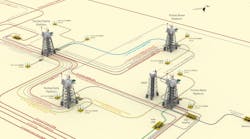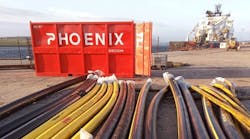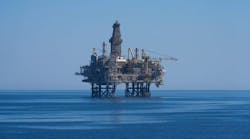New generation of independents
The merger dynamic among larger oil and gas producers today is responding When full uncertainty is recognized, the "cherry pick" portfolio typically lies above and to the "northwest" of the efficient frontier, indicating it included unnecessary and uncompensated risk.
to more than just economies of scale. The cost of buying reserves (or companies with reserves) averages $4-5/bbl, while the cost of drilling for reserves averages $7-8/bbl. The majors aren't the only producers taking advantage of this temporary disparity in costs. The independents are too, but not in the way one might expect:
- To cut steeply into fixed costs, merging companies are reducing combined staffs. When initial personnel cuts don't produce the projected results, second and third rounds begin wringing out capable and knowledgeable professionals, either directly or indirectly.
- Reducing overhead and meeting the mandates of regulators also means shedding physical assets, sometimes not the ones intended. These valued assets and sometimes regional market position are being surrendered at bargain prices.
- Digesting a merger freezes large producers for one to two years. Exploration and development operations go stagnant and budgets languish, while senior management focuses on meeting regulatory mandates.
Smaller producers - mostly independents - are picking through the trained professionals and assets shed by the merger process. Also, while the merging producers constrain drilling and development, smaller producers are moving in to tie up idled drilling units. Until retail product prices scale up sufficiently to allow for reasonable refining or downstream margins, large integrated producers will have to continue supporting under-performing assets with upstream margins.
As E&P activity responds to moderate oil and gas prices later this year, and the cost disparity between drilled reserves and purchased reserves narrows, these merged producers had better have the ability to find and lift oil. Otherwise, they will be out-maneuvered by a new generation of stronger independent producers.
Raw interactivity
The Internet is a third generation interactive device, and follows the telegraph and telephone, which each set earlier standards for two-way communications. Later developments in television were supposed to make the hurdle to interactivity, but never developed.
For the petroleum industry, the Internet is collapsing traditional workflows. The Internet's E-business capabilities are altering sales, inventory, ordering, and invoicing functions. For technical users, the Internet provides a means to search archived as well as topical data. For all its potential the Internet remains a very raw product:
- Ease of use: Compared with telephone, television, and other devices, computer-Internet combined functionality is slow and cumbersome. In the future, baud rates will have to grow exponentially to keep from being overwhelmed by exploding graphics and advertising content.
- Graphics help: Let's face it - the screen is a lot friendlier with accompanying graphics detail. The Net needs faster graphics, probably through a combination of zip packaging and much higher baud rates.
- Virus protection: Anyone with an interest in tweaking the establishment and some programming talent will continue to amuse themselves at businesses' expense. An effective block to new viruses or a way to reveal origin is badly needed.
- Quality standards: The Internet is an unregulated forum with wide access - a strength and a weakness. With no standards to qualify anything, methods are needed to ascertain site and content quality.
- Taxes coming: Inequities between non-taxed Internet functions (E-business) and traditional taxed competitors will eventually force this issue into the legal system. Sooner or later, Internet users will have the burden of service and commerce taxation.
- User fees: Governments have supported the cost of the Internet hardwire backbone, a measure that is normal for promising new technologies. However, there will have to be some means of passing through growth and maintenance costs.
Investors are betting these Internet challenges will be overcome in the coming decade, and the assumption is reasonable. Even now, Internet interactivity is becoming less of a novelty than the content being moved.
Readers wishing to respond to issues presented on this page or elsewhere in Offshore, or offer authored articles or article suggestions, should contact the editor by E-mail ([email protected]) or Fax (1-713-963-6296).



